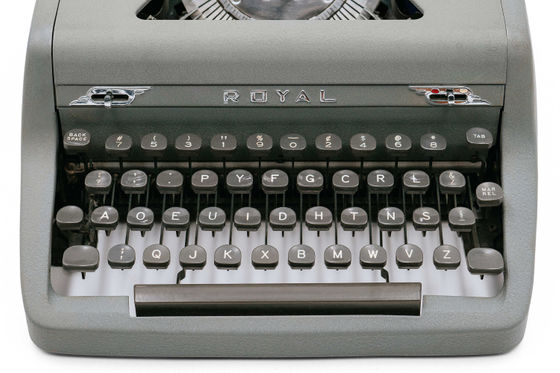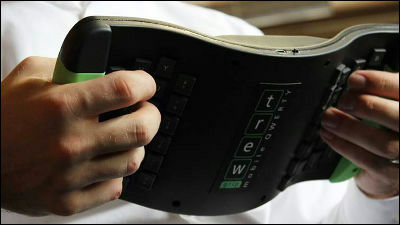History of QWERTY and Dvorak keyboard layouts

Most modern keyboards are QWERTY. The QWERTY layout has no regularity in the arrangement of letters, and there was some backlash when this layout first came out. Designer Martin Vyčari explains the mystery of this layout and the alternative layouts that emerged in opposition to the QWERTY layout.
The primitive tortureboard – Aresluna
It's not clear why the QWERTY layout was created. Some say it was designed so that the word 'TYPEWRITER' could be typed entirely on the first row, or that frequently used letter pairs were intentionally placed far apart to accommodate early typewriters that couldn't handle high-speed input, but it's unclear whether any of these are true.
When the QWERTY keyboard layout first came out, people who were outraged by its irregular layout began to produce alternative layouts to compete with it. One famous example is the 'DHIATENSOR' layout, developed by George C. Brickensderfer, which placed the most commonly used vowels and consonants in the bottom row. This keyboard layout was named the 'scientific keyboard' in opposition to the QWERTY keyboard, also known as the 'universal keyboard.' Several keyboards with this layout have appeared in the past, but they did not resonate with people who were already accustomed to the QWERTY keyboard.

Another famous keyboard layout is the 'Dvorak' keyboard. The Dvorak keyboard was a new layout designed in the 1930s by August Dvorak, a professor of education at the University of Washington. Professor Dvorak is a distant relative of Antonin Dvorak, the famous Czech composer of Symphony No. 9 'From the New World.' The composer's name is spelled 'Dvořák,' which is pronounced similarly to 'Dvořák' or 'Dvorak' in his native Czech.
Professor Dvorak's criticism of the QWERTY keyboard was harsh, calling it 'crude,' 'self-indulgent,' 'hodgepodge,' and 'an unpleasant irritant.' His reasons for this were that the QWERTY keyboard puts too much strain on the left hand, which many people find problematic. He cited the need to type more with the left hand, which is the non-dominant hand for many people, the strain on the fingers of the left hand, and the unnecessary up-and-down movement of the fingers.
Professor Dvorak, an educational psychologist, came to believe that improving the QWERTY keyboard was his responsibility while helping a student named Gertrude Ford correct a paper about typing errors.
The new keyboard took more than a decade to design. Professor Dvorak and his brother-in-law filed a patent in 1932 and described it as early as 1933 in a paper entitled 'Why and How Typographical Errors Occur.'
The initial Dvorak keyboard, which Professor Dvorak and his colleagues called the 'simplified keyboard,' looked like this: The awkward and rarely used semicolon was eliminated, the comma and dot moved from the bottom right to the top left, and even the numbers were rearranged for efficiency. The only keys that remained in the same positions as the QWERTY keyboard were the A and M.

The Dvorak keyboard reduced strain on the left hand, improved balance by using the stronger fingers more than the weaker ones, and only a few words had to be typed with the fingers of the same hand.
While the developers of the QWERTY keyboard took the mystery of the keyboard to their graves, Professor Dvorak attempted to explain the theory behind the Dvorak keyboard in detail in his paper 'A Theory of Typing Behavior.' His efforts did not stop at theory; he modified many typewriters to teach students the new keyboard layout and encouraged them to participate in shorthand contests. It is said that students who mastered the Dvorak keyboard outshone others in these contests.

Their efforts paid off. In 1944, the U.S. Navy, faced with a manpower shortage during World War II, conducted a trial of switching to the Dvorak keyboard, which promised to improve productivity. Fourteen typists familiar with the QWERTY keyboard were trained and, after just 50 hours, were able to type at the same speed as a QWERTY keyboard. Ultimately, everyone's typing speed increased by an average of 75%. One of them achieved a typing speed approximately 2.5 times faster than when using QWERTY. Typing accuracy also improved to an astonishing 68%.
The consensus was that Dvorak was 'easier to learn, more accurate, less tiring, more efficient, and overall easier and more enjoyable.' However, the Navy ultimately decided not to switch to Dvorak. For reasons never made clear, the bid was canceled by the Treasury Department, and the entire study was classified.

During the same period, improvements were made to the QWERTY keyboard, and results showed that typing speeds were faster with the QWERTY keyboard, forcing the Dvorak keyboard to struggle. Professor Dvorak wrote, 'They are tired of trying to do something worthwhile for humanity. They just don't want to change!' During the widespread use of personal computers, Dvorak saw some growth, as people with no experience using a typewriter were able to touch a keyboard for the first time. However, QWERTY ultimately dominated the market.
'Why did Dvorak fail? I don't think it did. It completely achieved its inventor's intended purpose: to provide an alternative to QWERTY and to inspire those who needed it. But in the end, very few people needed a new alternative. Dvorak may be fast and comfortable, but that's not the point. QWERTY isn't that bad, it's good enough for most people,' Vicari said.
Related Posts:
in Posted by log1p_kr







